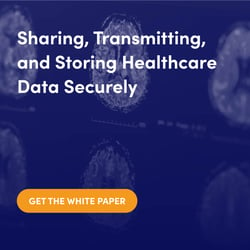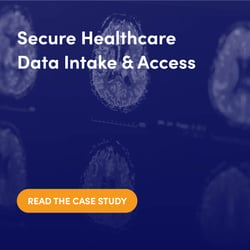Sharing medical and health data has many benefits not just for healthcare providers and professionals but also for patients - yet the security when sharing healthcare data is still a challenge.
Let’s look at the five most common challenges that healthcare providers experience when sharing sensitive health data.
But first, let's summarize why healthcare institutions even need secure data sharing.
Contents
Why do you need secure healthcare data sharing?
Data sharing challenges in healthcare
The future of secure data sharing for the healthcare industry
Why do you need secure healthcare data sharing?
Healthcare data sharing is crucial for the continuous development and improvement of healthcare systems, institutions, and individual patient care.
Especially in the digital age, health data is mostly in electronic form, which makes sharing it much easier and faster but not necessarily secure.
Healthcare data includes data related to each and every patient as well as data about healthcare institutions and systems. It consists of patient information like their health condition, various test results, personal and family health history, quality of life, etc.
It also contains a multitude of data collected and used when individuals interact with healthcare providers and systems. For example, records of implemented services, conditions of those services, or clinical outcomes concerning the services.
Healthcare data is extremely detailed, on personal as well as institutional level, which makes it extremely sensitive. And any sensitive data that can be potentially stolen and abused is sought after by cybercriminals.
These, among many other factors, create security challenges when it comes to healthcare data sharing.
Data sharing challenges in healthcare
1. Compliance with data security and data privacy laws and industry regulations
Before any healthcare institution even starts thinking about sharing their medical data with other organizations, healthcare professionals, or patients, they need to consider industry laws and regulations, especially when sharing electronic health data.
The main risks associated with data sharing in healthcare exist because medical records contain personal information.
In the EU, the regulatory framework for data protection is provided by the General Data Protection Regulation (GDPR), and it plays a key role in introducing a level playing field for data protection across the EU. When it comes to health data, GDPR recognizes health data as a special category of sensitive data – thus it’s governed by more demanding rules.
Starting in October 2024, health and healthcare organizations operating in the EU also need to adhere to the NIS2 Directive, which now considers healthcare as part of sectors of high criticality.
An important regulation that US healthcare providers must consider is the HIPAA Security Rule, which establishes standards for protecting health information in electronic form.
2. Data control and categorization
Closely related to compliance are data categorization and data control. There’s a variety of healthcare data to collect, store, and share, and various regulations apply to each group of health data. Thus, healthcare organizations need to have a clear data categorization and related controls in place.
For example, imagine this use case (based on GDPR laws):
A company hires a new employee who is required to go through a comprehensive health check-up at the beginning of their employment. Based on the check-up, the company will be able to pay for the employee’s healthcare.
During the check-up, a variety of medical data is collected, but not all of it will be shared with the employer company. The employee’s sensitive personal health data will be processed only by the healthcare provider, but administrative and financial health information (like scheduling of medical appointments or invoices for healthcare services) will be shared by the healthcare provider with the company’s HR department.
3. Strong identity and access management
When medical data is shared in electronic format, there’s an increased risk of it being accessed by unauthorized individuals, not just internal but also external. In the worst-case scenario, the data might get hacked, stolen, and misused.
Whether data is being shared, accessed, transmitted, or collaborated on by a human or an application, there needs to be a strong identity associated with every action.
To ensure only authorized access with the right level of access rights, healthcare organizations should have proper access management policies in place. With the right tool, access management and closing can be achieved by setting up access based on roles or group membership.
Similarly, various access rights should be granted to various personnel based on their needs, e.g. view-only rights, editing rights, sharing rights, etc.
Additionally, all access and data sharing should be recorded and tracked for auditing purposes. Without knowing who accessed your healthcare data, you cannot know for sure whether it’s been exposed to the wrong eyes or not.
4. Communication channels
The most common channel that healthcare providers use to share data is email. But nowadays we can also add video calls or instant messaging to the list.
No matter what channel is used, healthcare organizations need to ensure that the channels are authorized and interoperable. Otherwise, they risk non-compliance and regulatory fines.
Authorized channels follow all points mentioned above – they are compliant, follow data-related policies, and are in line with access management rules (including tracking and auditing).
5. Data security
Most importantly, the authorized channels must be highly secure. This means that the shared data is protected by robust encryption, and before it’s accessed or even shared, the sender as well as the recipient are verified using a strong authentication method (e.g. MFA).
This applies to data sharing between people – for example, a healthcare professional sharing the results of a blood test with a patient.
Another type of data sharing that healthcare organizations utilize is automated file sharing. This means regular sharing of big amounts of data – for example, daily sharing of health data between two facilities.
Important to remember is that data needs to be protected not just when it's in transit but also in use and at rest.
The future of secure data sharing for the healthcare industry
Secure data sharing has become a significant obstacle for hospitals and healthcare institutions, and related challenges persist regarding compliance, data and access management, and security.
Healthcare providers also often lack internal capacity or expertise and need support when it comes to data management and secure communications.
That’s where we at SSH Communications Security are happy to step in. With more than 20 years of expertise in the field and many customers in the healthcare industry, we offer an all-in-one solution for sharing, storing, and transmitting healthcare data securely.
Learn all about the solution here >>>
More healthcare-related resources:
Jani Virkkula
Currently employed by SSH.COM as Product Marketing Manager, Jani is a mixed-marketing artist with a strong background in operator and cybersecurity businesses. His career path of translator->-tech writer -> marketer allows him to draw inspiration from different sources and gives him a unique perspective on all types...


